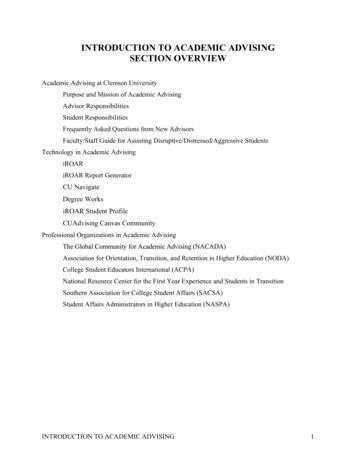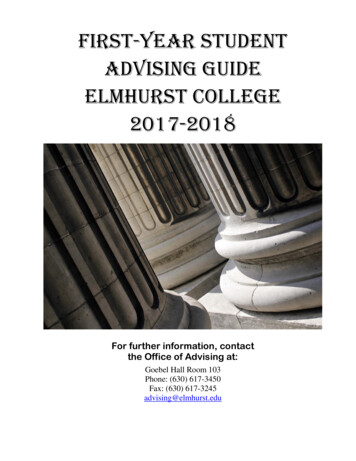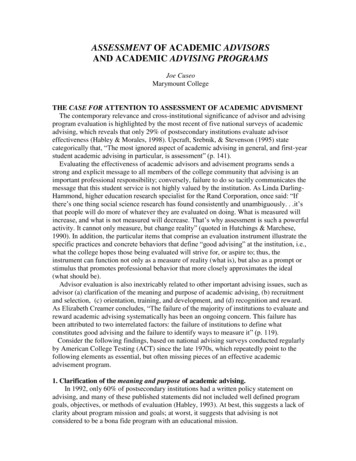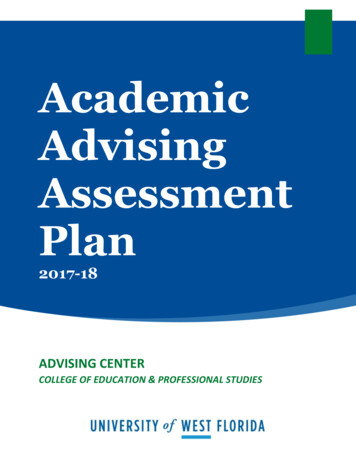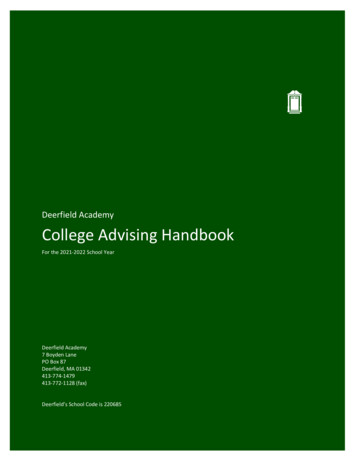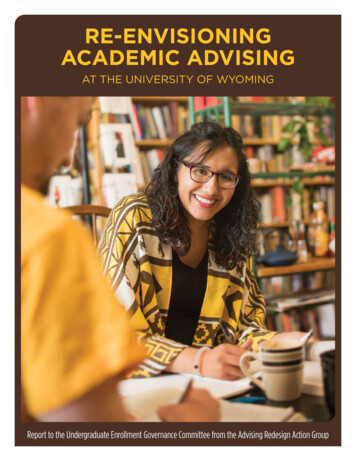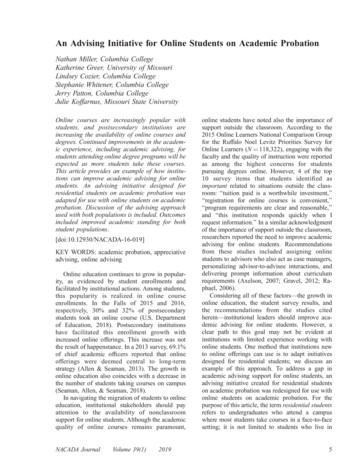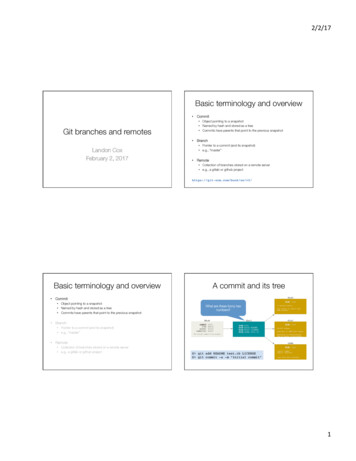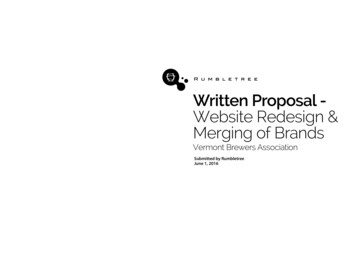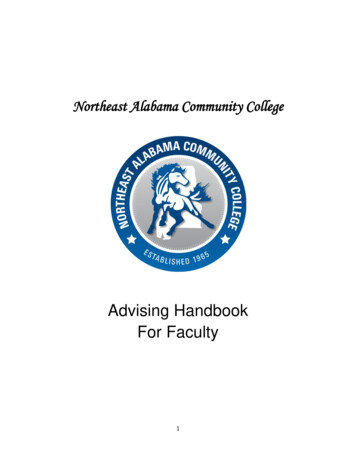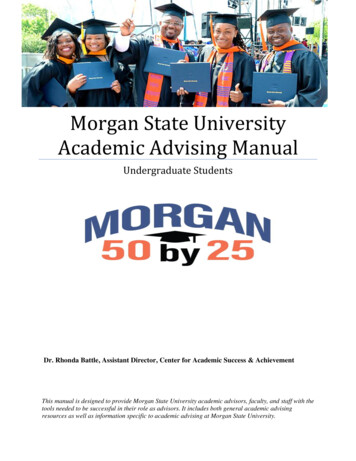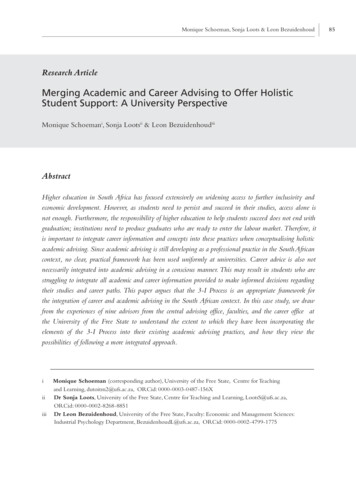
Transcription
Monique Schoeman, Sonja Loots & Leon BezuidenhoudResearch ArticleMerging Academic and Career Advising to Offer HolisticStudent Support: A University PerspectiveMonique Schoemani, Sonja Lootsii & Leon BezuidenhoudiiiAbstractHigher education in South Africa has focused extensively on widening access to further inclusivity andeconomic development. However, as students need to persist and succeed in their studies, access alone isnot enough. Furthermore, the responsibility of higher education to help students succeed does not end withgraduation; institutions need to produce graduates who are ready to enter the labour market. Therefore, itis important to integrate career information and concepts into these practices when conceptualising holisticacademic advising. Since academic advising is still developing as a professional practice in the South Africancontext, no clear, practical framework has been used uniformly at universities. Career advice is also notnecessarily integrated into academic advising in a conscious manner. This may result in students who arestruggling to integrate all academic and career information provided to make informed decisions regardingtheir studies and career paths. This paper argues that the 3-I Process is an appropriate framework forthe integration of career and academic advising in the South African context. In this case study, we drawfrom the experiences of nine advisors from the central advising office, faculties, and the career office atthe University of the Free State to understand the extent to which they have been incorporating theelements of the 3-I Process into their existing academic advising practices, and how they view thepossibilities of following a more integrated approach.iiiiiiMonique Schoeman (corresponding author), University of the Free State, Centre for Teachingand Learning, dutoitm2@ufs.ac.za, ORCid: 0000-0003-0487-156XDr Sonja Loots, University of the Free State, Centre for Teaching and Learning, LootsS@ufs.ac.za,ORCid: 0000-0002-8268-8851Dr Leon Bezuidenhoud, University of the Free State, Faculty: Economic and Management Sciences:Industrial Psychology Department, BezuidenhoudL@ufs.ac.za, ORCid: 0000-0002-4799-177585
86Journal of Student Affairs in Africa Volume 9(2) 2021, 85-100 DOI: 10.24085/jsaa.v9i2.3700We also map how the framework can be adapted to the broader South African context to inform anddevelop more holistic and professionalised advising practices, as well as to contribute towards students’success beyond university.KeywordsAcademic advising, career advising, higher educationIntroductionOver the past few years, the focus on widening access to higher education (HE) in SouthAfrica has extended to include a strong emphasis on student success. Significant progress hasbeen made to retain and successfully graduate students (Department of Higher Education andTraining [DHET], 2019). This can be attributed to increased efforts in advising,mentoring, orientation programmes, and early warning efforts to intervene with students atrisk of failing, counselling, and Supplemental Instruction that has been shown to impactstudent success (e.g. Cassells, 2018; Erasmus, 2017; Manik, 2014; Masehela & Mabika, 2017;Mayet, 2016). Among these interventions, academic advising stands out in internationalcontexts as having the greatest impact in assisting with timely degree completion (AnguloRuiz & Pergelova, 2013; Miller, 2013; Page et al., 2019), especially when it iscomprehensive, effective, and combined with other support efforts.Despite some progress in improving student success rates, there are many challenges tostill overcome. For example, approximately a third of students graduate within the minimumtime frame of three years (DHET, 2019), of whom 11% are unemployed (Centre for RiskAnalysis, 2021). The vast majority (at least 70%) of students who enter HE in SouthAfrica are also the first in their generation to do so (Universities South Africa, 2018). Thisimplies that most students might not be familiar with the options that they have whenthey access HE, nor are they familiar with how things work at university. These andsimilar challenges imply that HE institutions’ responsibility to help students succeed shouldnot end in assisting students to graduate. Instead, students also need to be guided inpostgraduate career-related matters (Gordon, 2006; McCalla-Wriggins, 2009). Researchshows that quality career advice (guidance and coaching), which will enhance clarityabout students’ career ambitions and interests, personal development plans, andemployability, should be considered in all institutions (Okolie et al., 2020). It is thus crucialthat in addition to academic advising, institutions should also look at career advising efforts.Internationally, academic advising has developed from an undefined and unexaminedactivity to the present era, where academic advising is a defined activity that is rigorouslyexamined in practice (Crookston, 1994; Daly & Sidell, 2013; Kuhn, 2008; O’Banion, 2009).
Monique Schoeman, Sonja Loots & Leon BezuidenhoudAs such, the practice has long been professionalised and the curriculum well conceptualised.However, it has only recently been professionalised in South Africa, as evidenced by therecent launch of South Africa’s first Academic Advising Association, ELETSA, in 2021. Theonly academic advising training programme in the country, which is accredited by the SouthAfrican Qualifications Authority, is offered by the University of the Free State (UFS). ThisHE institution has also been playing a central part in developing academic advising. Since2018, the Academic Advising Professional Development (AAPD) programme at the UFS hastrained more than 174 advisors from seven South African institutions. This programme hascontributed significantly to professionalising academic advising in the country.Given the importance of career advising in HE, and considering that academic advisingis still a relatively new concept in South Africa, the article suggests that this is a good time toconsider how we can integrate academic and career advising to provide more holistic supportto students. Currently, no specific framework for the provisioning of holistic support tostudents exists in South African HE. The objective of this paper is to argue for the integrationof academic and career advising and to propose a contextualised framework to achieve thisintegration.Literature ReviewAcademic and Career AdvisingAcademic and career advising has various definitions. A brief discussion of these definitionsfollows, and an argument for merging the two concepts, academic advising and career advising, ispresented.Academic advising is defined in different ways. For example, Kuhn (2008, p. 3) defines itas an action when “an institutional representative gives insight or direction to a collegestudent about an academic, social, or personal matter. The nature of this direction might be toinform, suggest, counsel, discipline, coach, mentor, or even teach.” Other definitionswhich include career advising, are more holistic. For example:Academic advising is a process where students and their academic advisers meet periodicallyto discuss progress, plans, ideas, and needs, as the student pursues academic and career goals.These meetings provide a time when students may talk with advisers who are knowledgeableabout available resources to aid student progress. Students are encouraged to meet with theiradvisers during the year to discuss academic progress, problems, or educational and career goals(Wartburg College, 2021, para. 1).At the UFS, the definition of academic advising also includes career advising; it states thatacademic advising is “an ongoing and intentional teaching and learning process to support andencourage advisees in aligning and fulfilling their personal, academic, and career goals. It is a87
88Journal of Student Affairs in Africa Volume 9(2) 2021, 85-100 DOI: 10.24085/jsaa.v9i2.3700high-impact practice directed at connecting, empowering, and supporting students to achieveacademic success” (University of the Free State [UFS], 2021, p. 6).Career advising has roots in academic advising, but it also forms part of careerdevelopment practices. However, career advising differs from the psychologically intensecareer counselling performed by registered counsellors and psychologists, as well as fromcareer services where the focus is more on connecting to the world of work and onshowcasing employability skills (Gordon, 2006; Herr et al., 2004; Hughey & Hughey, 2009;Niles & Harris-Bowlsbey, 2005). Career advising could be described as assisting students to“understand how their academic and personal interests, abilities, and values might relate tothe career fields they are considering and how to form their academic and career goalsaccordingly” (Gordon, 2005, para. 2). There are some overlaps between career advising andsimilar practices in HE, such as career counselling and career services. Some of theseoverlapping aspects include professional competencies used by advisors who provide careeradvice, counsellors who provide career counselling, and other professionals who collaboratewith career services. These professional competencies include relationship-building andcommunication competencies, career decision-making, planning, setting goals, and usingsimilar career theories and resources (Hartung & Niles, 2001; Hughey & Hughey, 2009).An Argument for Merging Academic and Career AdvisingStudents’ decisions regarding the selection of their academic programmes and future planningare seldom made without considering how these relate to potential careers (Gordon, 1984;Nkomo, 2018). Studies have also found that students identified career-related informationand concepts that are integrated into advice, as a continuous need throughout their studies(Chetty &Vigar-Ellis, 2012; Manik, 2015). Yet, degrees are often suggested for students withoutacknowledging their individual needs, motivation, or personality (Gordon & Steele, 2003).Undergraduate students are also known to start engaging with career services later in theireducation (Lynch & Lungrin, 2018). The lack of earlier engagement with career services mightcontribute to some students having unrealistic ideas about what certain careers entail, or aboutthe amount of coursework required to enter into certain careers, which in turn could result inmid-study course changes (Tudor, 2018). Gordon (2006) asserts that should advisors not assistwith this integration between academic programmes or majors and careers, and should theynot help students with this planning, students will tap into other sources that might not beaccurate, timely, or reliable. Thus, academic advisors should take advantage of their position tofacilitate a more integrated and career-oriented approach to academic advising. They shouldassist students in developing academic goals and career plans that are congruent with theirinterests and values in order to be successful (Hughey & Hughey, 2009).
Monique Schoeman, Sonja Loots & Leon BezuidenhoudA Framework for Merging Academic and Career AdvisingAlthough a few frameworks for the practical application of academic advice exist and areuseful, they do not intentionally include career advice (Bloom et al., 2013; Cate & Miller, 2015;Egan, 2010; Hutson & He, 2011). Virginia Gordon (2006) presented a framework for suchintegration between academic and career advising named the 3-I Process. This framework forthe integration of academic and career advising is highly recommended by the largest globalcommunity of academic advising, National Academic Advising Association (NACADA; e.g.)(Gordon, 2006; Hughey et al., 2009). The 3-I Process is widely used by academia in theUnited States of America (USA); however, it has not been adapted to different contextsbeyond the USA. Therefore, this paper describes and discusses how the 3-I Process could becontextualised to propose a more integrated approach at a South African university that isbased on academic advisors’ current practices.The 3-I ProcessThe 3-I Process consists of three main phases: inquire, inform, and integrate (Gordon, 2006)that derive from the following basic principles of career advising. These are:1. choosing and maintaining a career as a lifelong process;2. having effective career decision-making skills which are learned and used over a lifetime;3. having career decision-making centres on knowledge of oneself, information abouteducation opportunities, and facts about the world of work; and4. making career decisions that are based on values. To have a satisfying career, one needsto clarify a set of beliefs and act upon them.The 3-I Process was originally conceptualised as having three phases (see Figure 1). However,over the years, others have built on this framework. For example, Damminger (2009) furtherelaborated on these phases by breaking them down into seven steps in the careeradvising process. Although these steps seem to occur in a sequence, it is important to notethat regression is possible. Figure 1 provides a brief overview of these steps.89
90Journal of Student Affairs in Africa Volume 9(2) 2021, 85-100 DOI: 10.24085/jsaa.v9i2.3700Figure 1Three Phases and Seven Steps of the Career Advising Process (Damminger, 2009)During the Inquire phase of the 3-I Process, the advisor identifies and clarifies the students’academic and career concerns (Gordon, 2006). Damminger (2009) suggests distinguishingbetween two steps during the Inquire phase: building rapport and determining what thestudent’s knowledge and other needs are. Thus, the advisor takes time to establish a relationshipwith the student and to find out where their needs lie. Damminger (2009) found that students’educational experiences and subject interests are important factors during an integration ofcareer advising into advising sessions. Such discussions allow the advisor to understand themotivations underpinning students’ decision-making processes, which in turn helps the advisorto support the student. After the initial steps, advisors guide students towards the next phase ofthe 3-I Process, which is known as the Inform phase.The success of the Inform phase relies on the extent to which students acquire and effectivelyuse educational and career information (Gordon, 2006). In this phase, advisors need to helpstudents to gather relevant information that will guide their career choices. Such informationincludes: (a) personal information about their attributes such as likes and dislikes, or abouttheir strongest abilities and values; (b) educational information such as how their academicdecisions relate to possible career decisions; and (c) occupational information which is relatedto the student’s career goals. Building onto the Inform phase of the 3-I Process, Damminger(2009) suggests three steps to follow when students reflect on the information that could helpthem connect their educational and career choices. These are: (a) help students understand the
Monique Schoeman, Sonja Loots & Leon Bezuidenhoudconnections among their self-awareness, educational choices, occupational information, andacademic and career planning; (b) help students select interventions to assist in self-, major-,and career exploration and career planning; and (c) set career advising goals with the student.The first step of the Inform phase helps the student understand the academic careerconnection. After this, the advisor and student select the appropriate intervention, which maytake the form of a referral, should the student’s needs fall beyond an advisor’s scope of practice.After the selection of appropriate intervention, the 3-I Process concludes the Inform phasethrough collaborative goal-setting. This might include the identification of a certain career orcareer cluster and an exploration of the ways in which the student could move closer to suchcareers. Student success strategies such as time management and study skills can also be selectedas interventions or stepping stones towards goals.During the Integrate phase of the 3-I Process, the advisors assist students in integratinginformation, planning, and developing implementation plans, after which they support studentsto evaluate their accomplishments and they determine how a follow-up procedure wouldwork (Damminger, 2009). As part of the first step of this phase, advisors assist students inreviewing and integrating the information they have gathered or have reflected on. Duringthe first step, advisors further offer support to students in mapping the goals which they haveset in relation to an overarching implementation plan. This helps students align theirinterventions and goals, and ultimately reach their desired career track. The second step in theIntegrate phase consequently assists the advisor in teaching success strategies to studentswhen they need additional help.The 3-I Process is valuable to advisors; however, it might need to be adapted foreffective implementation at a South African university as it was developed in the USA.Learning from other contexts requires reflection or assessing whether practices could beadopted without any changes, or whether practices could be contextualised by adjustingcontent or processes to better align with local ways of being and doing. To position the 3-IProcess as a framework that could guide South African institutions in merging academicand career advising, we mapped the advising experiences of academic and career advisorsat one institution against this framework.MethodologyThe study was situated within the constructivist paradigm; participants’ experiences wereinterpreted to understand their views on advising. We implemented an instrumental case studyresearch design. Stake (2000) describes this design as using a single case example to gain insightinto an issue or to revise a generalisation. The study thus used the UFS as a case study to gaininsight into academic advising practices, and how advisors could adapt their practice to includecareer advice and provide more holistic support to students.91
92Journal of Student Affairs in Africa Volume 9(2) 2021, 85-100 DOI: 10.24085/jsaa.v9i2.3700Within the UFS, the research population comprised sixteen advisors who wereinvolved in academic and career advising at the institution. They were located at the careerservices office in the faculties and the Central Advising office of the Centre for Teachingand Learning (CTL). Owing to the small population, the study used non-probabilitypurposive sampling, where the research participants were deliberately selected for theirsuitability (Rule & John, 2011). Of the 16 faculty advisors who were invited toparticipate, six agreed. These six advisors included at least one advisor per faculty, exceptfor the faculties of Theology and Religion and Health Sciences, which were thesmallest faculties of the institution. Both advisors appointed in CTL, as well as the advisorfrom Career Services, agreed to participate. Of the six advisors, all but one had two ormore years’ experience, specifically in academic or career advising. The study collecteddata using semi-structured interviews. However, because the two central advisorsfulfilled similar functions, we conducted a semi-structured group interview. Thisallowed the participants to build on each other’s ideas when answering the questions.Participants were asked about: their views on academic advising and how these relatedto career advising; conceptual frameworks that guided their work; the challenges thatthey faced; and how they would describe an ideal advising framework. Thesequestions were included in the information that was emailed to the participants inadvance to help them prepare for the interviews, should they wish to do so.The data was analysed deductively and inductively in a two-cycle coding process.The first cycle in the coding process was done by deductively applying the themes ofthe 3-I Process to see whether and how the framework fits (Saldaña, 2009). A second cyclewas then implemented in the coding process to inductively code themes beyond thosesuggested by the 3-I Process framework (Saldaña, 2009).Findings and DiscussionThe interviews focused on an exploration of advisors’ experiences in integrating academicand career advising, and on an exploration of their perceptions about conceptualframeworks to guide their practice. The findings are firstly presented in terms of howparticipants view the relationship between academic and career advice and secondly howtheir advising practice is conceptually guided. Lastly, we incorporate relevant practices intothe 3-I Process for a more contextual representation of the framework.The Perceived Relationship between Academic Advice and Career AdviceThe advisors were asked how they viewed the role of career advising in relation to academicadvising, what the components of academic advice were, and what they perceived ascareer advice. Figure 2 illustrates how the advisors viewed academic advice, career adviceand the possible links between the two.
Monique Schoeman, Sonja Loots & Leon BezuidenhoudFigure 2The Relation of Career Advising to Academic AdvisingWhereas the advisors had a comprehensive understanding of what academic advice entailed,they were much more uncertain about career advising (Figure 2). However, some of theadvisors recognised the link between academic advising and career advising. For example, onenoted: “ you can’t even give academic advice without knowing what careers this personwants to go into, so you can’t separate the two.” Another advisor recognised the link, despitefeeling that it should not be as prominent: “ career advising is a part of academic advising,but it does not always go hand in hand with academic advising, so it’s not necessarily thatwhen a student comes for advising that you do career advising.”Various advisors indicated that they do not provide career advice, despite acknowledgingits importance. One such advisor stated: “I don’t really see it as separate; I know there are links,but it’s just that we solely concentrate on academic advice because it’s important for us thatstudents know what they have to register for, what they have to pass and those kinds ofthings.”Another advisor agreed: “So, I think our jobs are purely academic advising, but yes, there’sdefinitely a link to career advice as well”.Another advisor added: “I think the two are related, but I never saw my role as anacademic advisor as also per se a career advisor.” When probed, some of these advisorsalluded to not feeling equipped enough to provide career advice: “I don’t think we reallyhave at this moment all of the skills to do it ” and “ I’m not doing [it] at all because I’mnot an expert in that and I see myself as an expert in academic life and in what students needto do to obtain specifically a degree within our faculty.”93
94Journal of Student Affairs in Africa Volume 9(2) 2021, 85-100 DOI: 10.24085/jsaa.v9i2.3700Next, we explored what aspects of the 3-I Process were already being used by the advisorsin their academic advising practices. The various advisors were asked: “What steps do youfollow when you provide academic or career advice, and which conceptual framework is thisbased on?” The researcher deductively ascribed the answers of the advisors to the varioussteps in the 3-I Process. The findings indicated that each advisor follows different steps toprovide advice, even within the same type of advisory category.Advisors’ current steps and answers about the ideal framework provided ideas on how the3-I Process could be adapted to the institutional context. Figure 3 provides a visual summaryof this adapted framework.Figure 3Phases and Steps of the Adapted 3-I Process as an Integrated Academic andCareer Advising FrameworkThe adapted 3-I Process as an integrated academic and career advising framework still consistsof the 3-I phases (Inquire, Inform, Integrate), but additional steps have been incorporated into theInquire and Integrate phases. As part of the Inquire phase, advisors establish rapport with students.Only the central advisors explicitly mentioned establishing rapport with their students. Despitethis, we still include this step because establishing rapport is crucial to the advisor for buildinga working relationship that is based on mutual trust and respect. When a working relationshipis established, the student is more open to listen to the advisor’s advice and to value theinformation provided. The advisors also consult additional resources, which would help themunderstand the student’s background better. This is reflected by an advisor, who stated: “[I]
Monique Schoeman, Sonja Loots & Leon Bezuidenhoudusually print their verification registration document and then [I] print the curriculum of theyear.”Another advisor stated: “[I] would firstly draw the student’s study record to see what thestudent’s study history looks like, where the student is in their study period [to] get awhole ”This step has thus been added to consult additional sources in the adapted framework. Afterthe advisors have consulted additional resources, they determine the student’s knowledge andneed for seeking advice.During the second phase (Inform), the advisors help the student understand connectionsbetween information and sources. The participants recommended no additional steps. Althoughall the advisors’ practices loosely relate to the Inform phase, only two advisors explicitly statedusing occupational information. This confirms one part of the research problem: advisors donot deliberately integrate career information and concepts when advising students. In addition,although the advisors did not explicitly state the inclusion of goal-setting due to its importanceto know what the student is working towards, this step is still included.Although the advisors did not indicate creating a career plan with their students that couldfit into the first step of the Integrate phase, most indicated some form of integratinginformation and developing a plan. This was evident in an advisor’s answer: “ then they’vegot like a big colourful picture to see exactly, this is done, this is what I (the student) need todo If I (the student) meet these requirements, I know I will graduate.” However, asmentioned earlier, career information and concepts need to be integrated into advising.Therefore, the decision was to keep this step, with a focus on career concepts in additionto academic information. In the Integrate phase, the second step is supported by the advisors’responses to the steps they take: “ then implementation where the student goes andimplements by themselves.”; “ let them then go and read about it or visit the differentdepartments where those courses are situated.”; and “ they can make a responsible decisionon where to go.”Another advisor stated that she allows the student to make the final decision: “I can giveyou some options that you can consider before you make that final decision.” This step,therefore, empowers students to implement the plans made. Subsequently, students learnto become independent and a follow-up appointment is made for the last step of this phase.During the last step of the 3-I Process, the advisor and student evaluate the plans made andthe accomplishments achieved by means of the implementation step.Practical Application of 3-I ProcessThe previous section illustrated what this framework could look like in a context that differsfrom that of the UFS. This section will demonstrate how the adapted framework can beintegrated into practice. This can be explained through an understanding of the challengesthat the advisors raised together with their recommendations.95
96Journal of Student Affairs in Africa Volume 9(2) 2021, 85-100 DOI: 10.24085/jsaa.v9i2.3700The advisors mentioned various academic and career advising challenges that couldinfluence the integration of the adapted 3-I Process into practices at the UFS. These challengesinclude the following perceptions: The system (both nationally and institutionally) does notallow career advice to take place; advising is not yet professionalised; collaboration ischallenging; and feeling that they are ill-equipped to provide career advice. One advisornoted: “The system doesn’t allow it. For academic and career advising to take placecoherently. System meaning nationally and institutionally. Some institutions go deeper thanothers, but the system doesn’t allow it. For instance, career advice should start inschool and you know, the system has never allowed it, so by the time a student comes tothe institution; we first give them a word of career advice that they’ve never heard of they never focused on where their progression is leading them to what careers. By thetime they get to an institution of higher learning, it’s a whole new foreign concept.”In addition, participants mentioned that they found it challenging when they needed tohelp students find alternative directions, particularly when those directions were across faculty/year borders. One advisor stated: “ [It is challenging when] students who want to do acertain degree, mostly out of our faculty, and then do not meet the requirements, and now theyare forced to come to one of our degrees with lower admission requirements and then to helpthem find a way to make this work for them as well. The career [seems closed now] they’redevastated; they feel their dreams are shattered To help the student find an alternative thatwill still feel that they are doing something worthwhile [is a challenge].”The advisors also provided recommendations that could assist in addressing some persistentchallenges that the sector faces. For example, one recommendation is that academic and careeradvising should be integrated to assist students holistically. An advisor highlighted this bystating that: “ both of them (academic and career advising) will have to run together
HE institution has also been playing a central part in developing academic advising. Since 2018, the Academic Advising Professional Development (AAPD) programme at the UFS has trained more than 174 advisors from seven South African institutions. This programme has contributed significantly to professionalising academic advising in the country.
